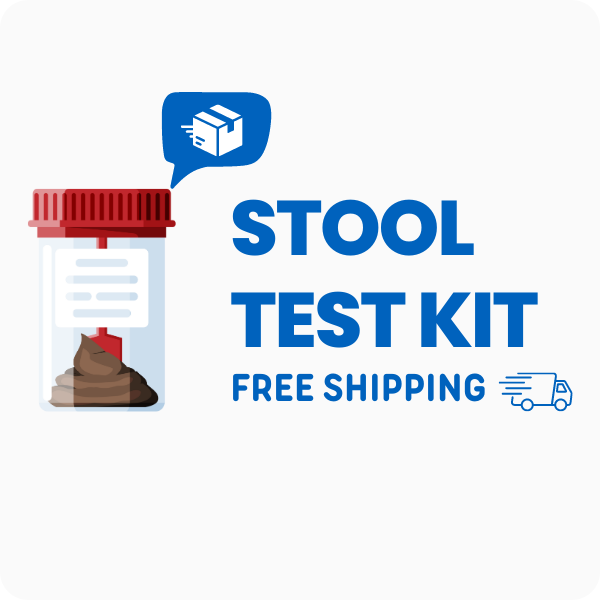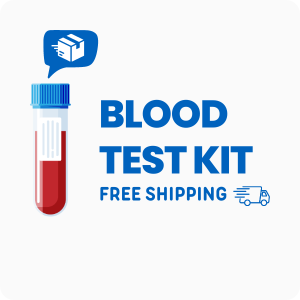Ordering the Comprehensive GI-Effects | DNA Stool Test | 1-Day Collection
Ordering the Comprehensive GI-Effects | DNA Stool Test | 1-Day Collection helps you find out what is happening in your digestive system by checking for bacteria, yeast, parasites, and signs of inflammation. This test uses advanced DNA technology to look at your gut bacteria and other markers, which can help you and your doctor make decisions about your digestive health. Interestingly, this test can also show if you have certain drug resistance genes, which may help your doctor choose the best treatment if you have an infection.
When ordering this test, you get a detailed look at your gut health with these specific benefits:
- Checks for both good and bad gut bacteria using DNA analysis.
- Finds hidden infections like parasites, yeast, and harmful bacteria.
- Measures markers for inflammation, which can help tell the difference between IBS and IBD.
- Shows how well your body digests and absorbs nutrients.
- Identifies drug resistance genes to help guide treatment choices.
- Includes a single, easy-to-use home collection kit.
Who Should Consider Gut Microbiome and Digestive Function Testing
People who have ongoing stomach pain, bloating, or changes in their stool may benefit from this test. For example, someone who has tried different diets and probiotics but still has gas and discomfort might use this test to find out if there is an imbalance in their gut bacteria or a hidden infection.
Ordering this test may also be helpful in these situations:
- Frequent constipation or diarrhea that does not improve with simple changes.
- Food intolerances or reactions that are hard to explain.
- Unexplained tiredness or trouble focusing that may be linked to gut issues.
- Family history of digestive problems like IBD or celiac disease.
- Unexpected weight changes that could be related to how your body absorbs nutrients.
- If you suspect parasites, it is more useful to order the 3-day DNA stool tests at no additional charge.
This test gives you clear answers about your gut bacteria, infections, and how well your body digests food, which can help you and your doctor make a plan to improve your symptoms. Waiting to order this test could mean missing early signs of problems that are easier to manage when found sooner.
Preparing for Stool Analysis and Gut Health Testing
Fasting is not required for this test, but you should follow the collection instructions provided in your kit for the most useful results. Always go by any directions your doctor or healthcare provider gives you to make sure your sample is collected the right way.
Labs Included When Ordering Your Comprehensive GI-Effects | DNA Stool Test | 1-Day Collection
| Test Name | Reference Range | What the Test Means | Low and High Levels of Comprehensive GI-Effects | DNA Stool Test | 1-Day Collection |
|---|---|---|---|
| Gut Bacteria (Commensal/Opportunistic) | |||
| Bacteroides-Prevotella group | Within lab-specific range | These bacteria help break down plant fibers and support gut balance. They are important for normal digestion and keeping harmful bacteria in check. | High levels mean there may be an imbalance, sometimes linked to inflammation or certain diets.
Low levels mean your gut may not be breaking down fiber well, which can affect digestion. |
| Faecalibacterium prausnitzii | Within lab-specific range | This bacteria makes short-chain fatty acids that help reduce gut inflammation and support the gut lining. | High levels mean your gut may be making more anti-inflammatory compounds.
Low levels mean you may have more inflammation or a weaker gut barrier. |
| Lactobacillus spp. | Within lab-specific range | Lactobacillus helps keep harmful bacteria under control and supports digestion. | High levels mean there could be an imbalance, sometimes seen with probiotic overuse.
Low levels mean your gut may have less protection against harmful bacteria. |
| Bifidobacterium spp. | Within lab-specific range | Bifidobacterium helps digest fiber and supports the immune system in the gut. | High levels mean your gut may be responding to certain foods or supplements.
Low levels mean you may have less support for digestion and immune function. |
| Pathogens and Harmful Bacteria | |||
| Escherichia coli | Within lab-specific range | E. coli is a normal gut bacteria, but some types can cause infection and symptoms like diarrhea. | High levels mean there may be an infection or imbalance.
Low levels mean your gut may lack some normal bacteria. |
| Clostridium difficile | Not detected | This bacteria can cause severe diarrhea and inflammation if present in high amounts. | High levels mean a possible infection that needs treatment.
Low levels mean no infection is present. |
| Campylobacter spp. | Not detected | Campylobacter can cause food poisoning and stomach upset if found in the stool. | High levels mean a possible infection.
Low levels mean no infection is present. |
| Shiga toxin E. coli | Not detected | This type of E. coli can cause severe stomach pain and bloody diarrhea if present. | High levels mean a dangerous infection is present.
Low levels mean no infection is present. |
| Yeast and Fungi | |||
| Yeast | Not detected or within lab-specific range | Yeast overgrowth can cause bloating, gas, and other digestive symptoms. | High levels mean possible yeast overgrowth, which can cause symptoms.
Low levels mean no yeast overgrowth is present. |
| Fungi | Not detected | Fungi in the stool may point to an imbalance or infection. | High levels mean a possible fungal infection.
Low levels mean no fungal infection is present. |
| Parasites | |||
| Cryptosporidium | Not detected | This parasite can cause watery diarrhea and stomach cramps if present. | High levels mean a possible parasitic infection.
Low levels mean no infection is present. |
| Giardia lamblia | Not detected | Giardia is a parasite that can cause diarrhea, gas, and stomach pain. | High levels mean a possible infection.
Low levels mean no infection is present. |
| Entamoeba histolytica | Not detected | This parasite can cause severe diarrhea and stomach pain if found in the stool. | High levels mean a possible infection.
Low levels mean no infection is present. |
| Inflammation and Immune Markers | |||
| Calprotectin | <50 | Calprotectin is a marker for gut inflammation and helps tell the difference between IBS and IBD. | High levels mean there is inflammation in the gut, often seen in IBD.
Low levels mean little or no inflammation is present. |
| Eosinophil Protein X (EPX) | <4.6 | EPX is an immune marker that can show allergic or inflammatory reactions in the gut. | High levels mean possible allergic or immune reactions in the gut.
Low levels mean no allergic or immune reaction is present. |
| Fecal sIgA | 510-2040 | sIgA is an antibody that helps protect the gut from infections and supports immune function. | High levels mean your immune system is reacting to something in the gut.
Low levels mean your gut may have less immune protection. |
| Digestion and Absorption | |||
| Pancreatic Elastase | >200 | This enzyme shows how well your pancreas is working to help digest food. | High levels mean normal or good pancreatic function.
Low levels mean your pancreas may not be making enough enzymes for digestion. |
| Fecal Fat (Total) | <7 | This test checks if your body is absorbing fat from food properly. | High levels mean your body may not be absorbing fat well.
Low levels mean normal fat absorption. |
| Products of Protein Breakdown (Total) | Within lab-specific range | Measures how well your body breaks down and uses protein from food. | High levels mean your body may not be digesting protein well.
Low levels mean normal protein digestion. |
| Metabolic Markers | |||
| Short Chain Fatty Acids (Total) | Within lab-specific range | These are made by gut bacteria and help keep the gut lining healthy and reduce inflammation. | High levels mean your gut bacteria are very active, sometimes linked to certain diets.
Low levels mean your gut may not be making enough of these helpful compounds. |
| Beta-Glucuronidase | Within lab-specific range | This enzyme is made by gut bacteria and can affect how your body gets rid of toxins. | High levels mean your body may be recycling toxins, which can affect hormone balance.
Low levels mean less recycling of toxins. |
| Other Markers | |||
| Fecal Occult Blood | Not detected | Checks for hidden blood in the stool, which can be a sign of bleeding in the gut. | High levels mean there may be bleeding in the digestive tract.
Low levels mean no blood is present. |
| HpSA – H. pylori | Not detected | Checks for H. pylori, a bacteria that can cause stomach ulcers and pain. | High levels mean a possible H. pylori infection.
Low levels mean no infection is present. |
| Color, Consistency | Normal | Looks at the color and texture of your stool, which can give clues about digestion and gut health. | High levels mean abnormal findings may point to digestive issues.
Low levels mean normal findings. |
Reference ranges may change slightly as labs update their methods and guidelines. Always check your report for the most current reference values.
Comprehensive GI-Effects | DNA Stool Test | 1-Day Collection FAQ
Is there Comprehensive GI-Effects | DNA Stool Test | 1-Day Collection testing near me?
This is a home test kit, so you can collect your sample locally and use the draw location link to find a convenient drop-off site. For people with ongoing digestive symptoms, being able to collect the sample at home makes it easier to get tested without extra travel or waiting.
How do I interpret the test results?
While your doctor should review your results, we also offer a one-on-one test results review with our clinical team to help you understand your report and next steps.
What is the cost of the test?
The price you see includes standard shipping to you and back to the lab, but draw fees may apply. Ordering this test can help you find the cause of digestive symptoms sooner, which may help you feel better faster.
How often should I retest?
Retesting is usually recommended every 6-12 months, especially if you are making changes to your diet or treatment plan, or if your symptoms return. Regular testing helps track changes in your gut bacteria and digestion so you and your doctor can adjust your plan as needed.
How accurate is the test?
This test uses advanced DNA analysis (PCR) to detect bacteria, yeast, and parasites, with a specificity of 98% and sensitivity of 97%. TrueHealthLabs.com partners with CLIA-certified and CAP-certified laboratories to uphold rigorous testing standards for dependable results.
Important Notes
- This kit cannot be mailed or collected in New York State.
Medical Review Board
Reviewed by Jeff Donohue M.D. from Body Logic and Brady Hurst DC, CCCN. Written by True Health Lab’s team of editorial health contributors.
Disclaimer: This information is for educational purposes only and not intended as medical advice. Consult your healthcare provider for personalized guidance.
Why Customers Trust True Health Labs – What People are saying
Also rated 4.6 out of 5 based on 3452 ShopperApproved reviews- See all TrueHealthLabs.com reviews.








